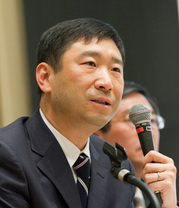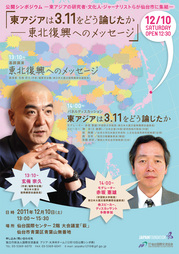Eastern Japan's Display of Vitality
Yan Chen
Chairman, Executive Committee, Japan Corporation (China) Research Institute
In December 2011, I participated in the Japanese Studies Forum held in Higashi Matsushima, Miyagi Prefecture. There, I witnessed at first hand the imprint made by the 3.11 disasters and the efforts Higashi Matsushima is making to rebuild its community. This was one of many occasions where I set foot in Miyagi and other parts of Eastern Japan following the catastrophic March earthquake. With each subsequent visit, I noticed the progress the region has made to regenerate. Observing the indomitable spirit of the Japanese, optimism about the future and energy to rebuild their lives in the aftermath of 3.11, I am convinced that vitality will be restored to Japan. In a bid to inform Chinese readers of the current situation in Japan as well as to transmit the experiences and lessons that can be learnt from the March disasters, I have written about each encounter I've had with the Japanese, no matter how small they are. I am particularly interested in the vitality that Eastern Japan has displayed.

East Asia Japanese Studies Forum
High degree of solidarity
Eastern Japan has fallen victim to repeated natural disasters over the course of history. One of the characteristics of this region is the wisdom local people have acquired about natural disasters and their ability to work together to overcome them. Here's a story I heard at Sendai Airport. Immediately after the earthquake struck, the airport staff, fearing that a tsunami would follow, urged passengers and neighborhood residents to evacuate to the airport terminal building. The staff personally helped many elderly evacuees climb to the top. The airport did not have enough food or water in store for the thousand-plus people who took shelter there. Some supplies could be found in airport kiosks that escaped damages, but that wasn't enough. Yet the evacuees managed to survive the next few days on what little they could find. One airport staff member told me that not a single life was lost during that time.
I heard a similar story at a banquet hall I visited. A primary school graduation ceremony was taking place when the earthquake struck. The manager of the hall knew that a tsunami would follow the violent tremor. He convinced the students and their parents to remain in the hall because the building was solid and tall. The children and their parents must have been worried about their homes. However, they decided to stay after repeated pleas by the manager not to leave. That probably saved their lives. Past experiences with natural disasters are invaluable in overcoming new disasters. It's equally important to help each other out. A strong sense of unity was prevalent everywhere I went in the Tohoku region.
Quick recovery
I witnessed the unexpected speed with which recovery was taking place throughout Eastern Japan. A paint factory in Iwate that I visited was operating near normal soon after the earthquake. When the earthquake struck, the president of this factory was travelling abroad. Instead of waiting for his return, the employees took the initiative to clean up the factory and repair the machines. It took several days before the president could make his way back to the factory. By that time, parts of the production line has already been in operation. As we stood in front of the production line, the president told me that it wasn't as if there was an emergency manual with instructions on what to do in the event of an earthquake. Rather, the employees knew they had to get production going in order to meet customer deadlines. Following the Fukushima nuclear reactor accident, electricity conservation measures were put into effect. At the height of the summer, I visited a parts manufacturer in Miyagi Prefecture that suffered relatively little from the earthquake. The factory windows were covered with rattan blinds and the factory was almost deserted. Clad in a tie-free short-sleeve shirt, the factory manager told me that they shifted production to nighttime when electricity demand was not as high. During the day, the air conditioning was turned off to conserve energy; the rattan blinds helped to shut out the sun. The impact of energy conservation on production was not as severe as initially expected. By thinking of alternative ways to handle the situation, production at these factories continued with minimal disruption.
Extensive support network
I met a retiree in Tokyo who went to the stricken areas of Tohoku twice within a month after the March disasters. He travelled north on a long distance bus with nothing but a few days' worth of food and water as well as a sleeping bag. He told me that he doesn't have any special talent or the support of any organization, but he felt he could at least offer companionship to those who were affected by the earthquake. Volunteers from all over Japan, young and old, were quick to offer their help, whether it be through transporting food, collecting donations or removing debris. I went to the three affected prefectures on numerous occasions. I rarely heard theft or safety concerns being mentioned. Everybody believed help would be coming its way. This tremendous support system has been a great source of strength for those affected by the disasters. Many offered their help when they saw others suffering, regardless of their age. This spontaneous help was evident everywhere in the aftermath of the Great East Japan Earthquake.
Eastern Japan's display of vitality
Eastern Japan's vitality is clearly evident in the solidarity of its people, recovery efforts and support system displayed in the aftermath of the March disasters. One Chinese reporter said he wrote numerous articles about the March earthquake not just for professional reasons, but as a way to enhance his understanding of Japan. He added that articles related to the March disasters are readily available on the Internet. Readers can also send in their comments. Despite this plethora of information, very few are critical about Japan, unlike in the past. Another Chinese reporter wrote that the Japanese bore the cross of the earthquake and tsunami on behalf of the rest of the world, therefore, it is only natural that humankind offers support for Japan. The reporter continues that the experiences and lessons learnt from the March disasters should be shared by all mankind and committed to memory.
I believe that Eastern Japan, with its vitality, is a role model for the rest of the world. Natural disasters will never cease, but mankind has the power to unite and rebuild after each calamity, just as the people of Eastern Japan has shown us.
Public Symposium, December 2011: a gathering of East Asian researchers, intellectuals and journalists in Sendai.
A symposium titled Higashi asia wa 3.11 wo do ronjitaka--Tohoku fukko e no messeiji (How East Asia Saw 3.11: a Message for Reconstruction in Tohoku) was held in conjunction with "The 2nd East Asia Japanese Studies Forum" that took place in Matsushima, Miyagi Prefecture. Speakers included Sokyu Genyu, Norio Akasaka and Yan Chen.
http://www.jpf.go.jp/j/intel/new/1111/11-01.html
 Yan Chen, Chairman, Executive Committee, Japan Corporation (China) Research Institute
Yan Chen, Chairman, Executive Committee, Japan Corporation (China) Research Institute
PhD, Faculty of Economics, Graduate School of Economics, Keio University (1999). Specialization includes Japanese corporations, Japanese economy and Sino-Japanese relations. Economics editor for numerous Chinese media. Author of over one thousand articles in Japanese media including magazines such as Shukan Toyo Keizai (Asia Economics Weekly) and Aera.
Related Events
Back Issues
- 2022.11. 1 Inner Diversity<3> <…
- 2022.9. 5 Report on the India-…
- 2022.6.24 The 48th Japan Found…
- 2022.6. 7 Beyond Disasters - …
- 2021.3.10 Crossing Borders, En…
- 2020.7.17 A Millennium of Japa…
- 2020.3.23 A Historian Interpre…
- 2019.11.19 Dialogue Driven by S…
- 2019.10. 2 The mediators who bu…
- 2019.6.28 A Look Back at J…




